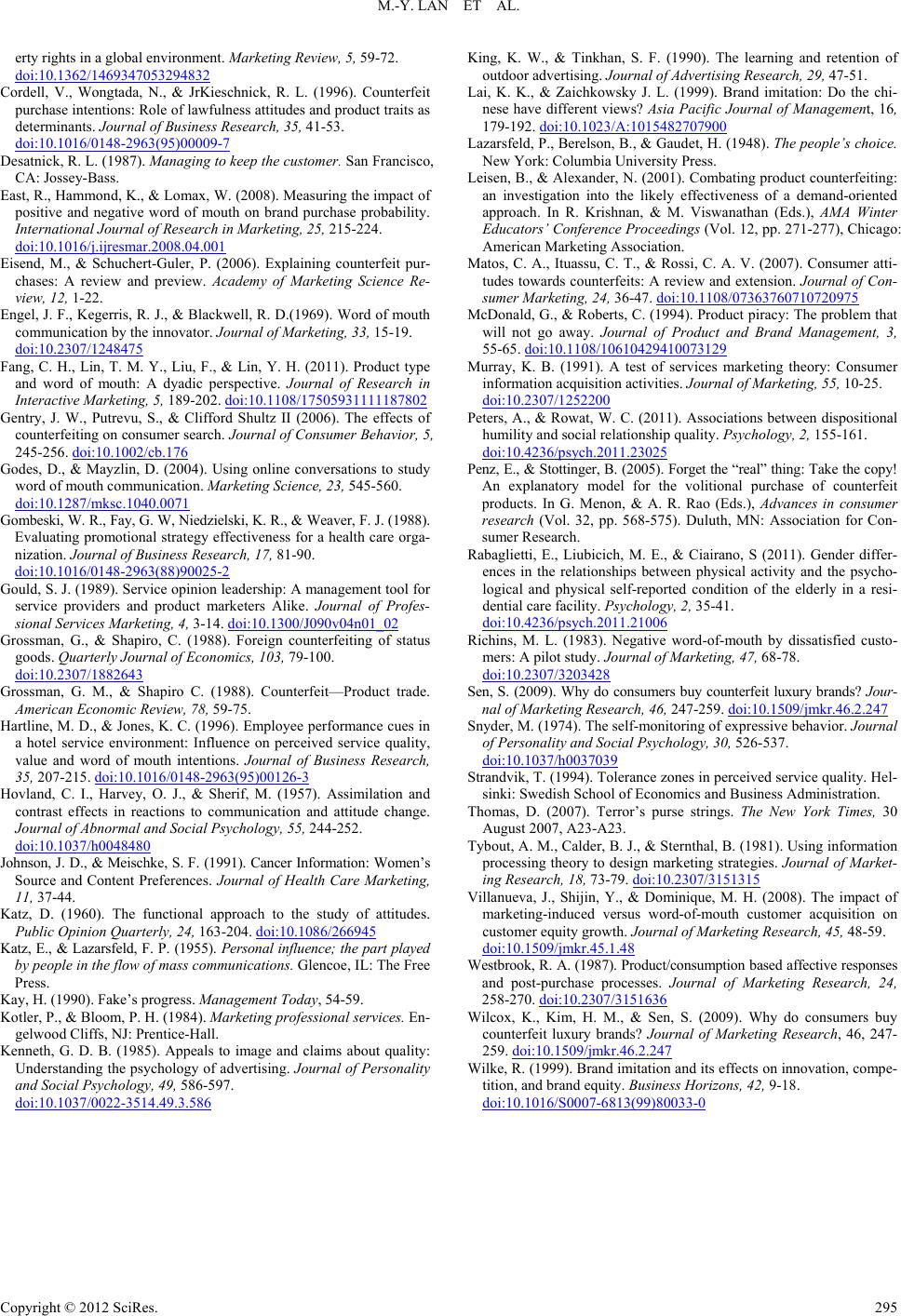
M.-Y. LAN ET AL.
Copyright © 2012 SciRes. 295
erty rights in a global environment. Marketing Review , 5, 59-72.
doi:10.1362/1469347053294832
Cordell, V., Wongtada, N., & JrKieschnick, R. L. (1996). Counterfeit
purchase intentions: Role of lawfulness attitudes and product traits as
determinants. Jou rnal of Busin ess Research, 35, 41-53.
doi:10.1016/0148-2963(95)00009-7
Desatnick, R. L. (1987). Managing to keep the customer. San Francisco,
CA: Jossey-Bass.
East, R., Hammond, K., & Lomax, W. (2008). Measuring the impact of
positive and negative word of mouth on brand purchase probability.
International Journal of Research in Marketing, 25, 215-224.
doi:10.1016/j.ijresmar.2008.04.001
Eisend, M., & Schuchert-Guler, P. (2006). Explaining counterfeit pur-
chases: A review and preview. Academy of Marketing Science Re-
view, 12, 1-22.
Engel, J. F., Kegerris, R. J., & Blackwell, R. D.(1969). Word of mouth
communication by the innovator. Journal of Marketing, 33, 15-19.
doi:10.2307/1248475
Fang, C. H., Lin, T. M. Y., Liu, F., & Lin, Y. H. (2011). Product type
and word of mouth: A dyadic perspective. Journal of Research in
Interactive Marketing, 5, 189-202. doi:10.1108/17505931111187802
Gentry, J. W., Putrevu, S., & Clifford Shultz II (2006). The effects of
counterfeiting on consumer search. Journal of Consumer Behavior, 5,
245-256. doi:10.1002/cb.176
Godes, D., & Mayzlin, D. (2004). Using online conversations to study
word of mouth communication. Marketing Science, 23, 545-560.
doi:10.1287/mksc.1040.0071
Gombeski, W. R., Fay, G. W, Niedzielski, K. R., & Weaver, F. J. (1988).
Evaluating promotional strategy effectiveness for a health care orga-
nization. Journal of Business Research, 17, 81-90.
doi:10.1016/0148-2963(88)90025-2
Gould, S. J. (1989). Service opinion leadership: A management tool for
service providers and product marketers Alike. Journal of Profes-
sional Services Marketing, 4 , 3-14. doi:10.1300/J090v04n01_02
Grossman, G., & Shapiro, C. (1988). Foreign counterfeiting of status
goods. Quarterly Journal of Economics, 103, 79-100.
doi:10.2307/1882643
Grossman, G. M., & Shapiro C. (1988). Counterfeit—Product trade.
American Economic Review, 78, 59-75.
Hartline, M. D., & Jones, K. C. (1996). Employee performance cues in
a hotel service environment: Influence on perceived service quality,
value and word of mouth intentions. Journal of Business Research,
35, 207-215. doi:10.1016/0148-2963(95)00126-3
Hovland, C. I., Harvey, O. J., & Sherif, M. (1957). Assimilation and
contrast effects in reactions to communication and attitude change.
Journal of Abnormal and Social Psychology, 55, 244-25 2.
doi:10.1037/h0048480
Johnson, J. D., & Meischke, S. F. (1991). Cancer Information: Women’s
Source and Content Preferences. Journal of Health Care Marketing,
11, 37-44.
Katz, D. (1960). The functional approach to the study of attitudes.
Public Opinion Quarterly, 24, 163-204. doi:10.1086/266945
Katz, E., & Lazarsfeld, F. P. (1955). Personal influence; the part played
by people in the flow of mass communications. Glencoe, IL: The Free
Press.
Kay, H. (1990). Fake’s progress. Management Today, 54 -59.
Kotler, P., & Bloom, P. H. (1984). Marketing professional services. En-
gelwood Cliffs, NJ: Prentice-Hall.
Kenneth, G. D. B. (1985). Appeals to image and claims about quality:
Understanding the psychology of advertising. Journal of Personality
and Social Psychology, 49, 586-597.
doi:10.1037/0022-3514.49.3.586
King, K. W., & Tinkhan, S. F. (1990). The learning and retention of
outdoor advertising. Jou rn al o f Advertising Research, 29, 47-51.
Lai, K. K., & Zaichkowsky J. L. (1999). Brand imitation: Do the chi-
nese have different views? Asia Pacific Journal of Management, 16,
179-192. doi:10.1023/A:1015482707900
Lazarsfeld, P., Berelson, B., & Gaudet, H. (1948). The people’s choice.
New York: Columbia University Press.
Leisen, B., & Alexander, N. (2001). Combating product counterfeiting:
an investigation into the likely effectiveness of a demand-oriented
approach. In R. Krishnan, & M. Viswanathan (Eds.), AMA Winter
Educators’ Conference Proceedings (Vol. 12, pp. 271-277), Chicago:
American Marketing Association.
Matos, C. A., Ituassu, C. T., & Rossi, C. A. V. (2007). Consumer atti-
tudes towards counterfeits: A review and extension. Journal of Con-
sumer Marketing, 24, 36-47. doi:10.1108/07363760710720975
McDonald, G., & Roberts, C. (1994). Product piracy: The problem that
will not go away. Journal of Product and Brand Management, 3,
55-65. doi:10.1108/10610429410073129
Murray, K. B. (1991). A test of services marketing theory: Consumer
information acq u i si t io n ac t i vi t ie s . Journal of Marketing, 55, 10-25.
doi:10.2307/1252200
Peters, A., & Rowat, W. C. (2011). Associations between dispositional
humility and social relationship quali ty. Psychology, 2, 155-161.
doi:10.4236/psych.2011.23025
Penz, E., & Stottinger, B. (2005). Forget the “real” thing: Take the copy!
An explanatory model for the volitional purchase of counterfeit
products. In G. Menon, & A. R. Rao (Eds.), Advances in consumer
research (Vol. 32, pp. 568-575). Duluth, MN: Association for Con-
sumer Research.
Rabaglietti, E., Liubicich, M. E., & Ciairano, S (2011). Gender differ-
ences in the relationships between physical activity and the psycho-
logical and physical self-reported condition of the elderly in a resi-
dential care facility. Psychology, 2, 35-41.
doi:10.4236/psych.2011.21006
Richins, M. L. (1983). Negative word-of-mouth by dissatisfied custo-
mers: A pilot study. Journal of Marketing, 47, 68-78.
doi:10.2307/3203428
Sen, S. (2009). Why do consumers buy counterfeit luxury brands? Jour-
nal of Marketing Research, 46, 247-259. doi:10.1509/jmkr.46.2.247
Snyder, M. (1974). The self-monitoring of expressive behavior. Journal
of Personality and Social Ps y c h o l o g y , 30, 526-537.
doi:10.1037/h0037039
Strandvik, T. (1994). Tolerance zones in perceived service quality. Hel-
sinki: Swedish School of Economics and Business Administration.
Thomas, D. (2007). Terror’s purse strings. The New York Times, 30
August 2007, A23-A23.
Tybout, A. M., Calder, B. J., & Sternthal, B. (1981). Using information
processing theory to design marketing strategies. Journal of Market-
ing Research, 18, 73-79. doi:10.2307/3151315
Villanueva, J., Shijin, Y., & Dominique, M. H. (2008). The impact of
marketing-induced versus word-of-mouth customer acquisition on
customer equity growth. Journal of Marketing Res ear ch, 45, 48-59.
doi:10.1509/jmkr.45.1.48
Westbrook, R. A. (1987). Product/consumption based affective responses
and post-purchase processes. Journal of Marketing Research, 24,
258-270. doi:10.2307/3151636
Wilcox, K., Kim, H. M., & Sen, S. (2009). Why do consumers buy
counterfeit luxury brands? Journal of Marketing Research, 46, 247-
259. doi:10.1509/jmkr.46.2.247
Wilke, R. (1999). Brand imitation and its effects on innovation, compe-
tition, and brand equity. Business Horizons, 42, 9-18.
doi:10.1016/S0007-6813(99)80033-0